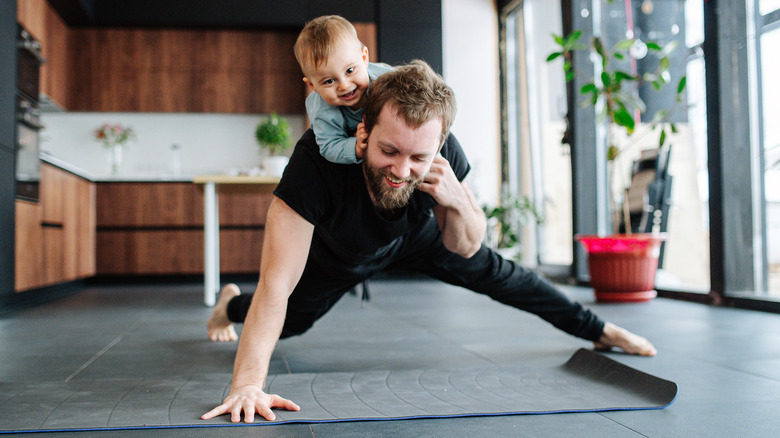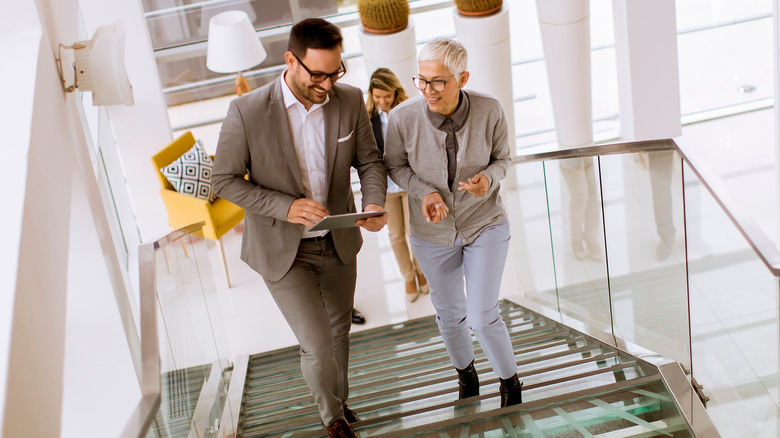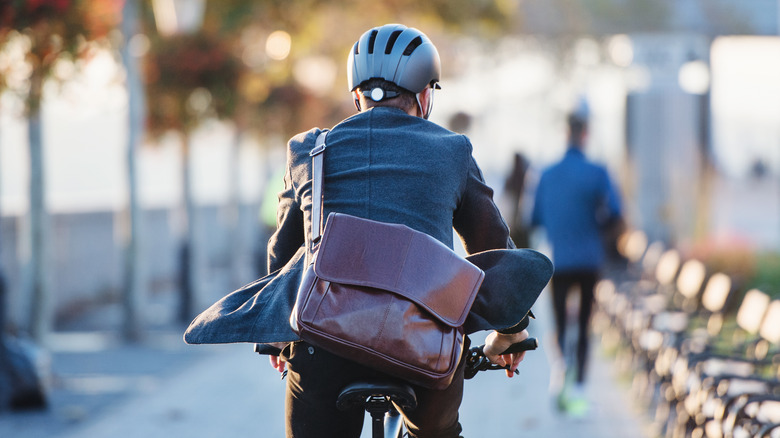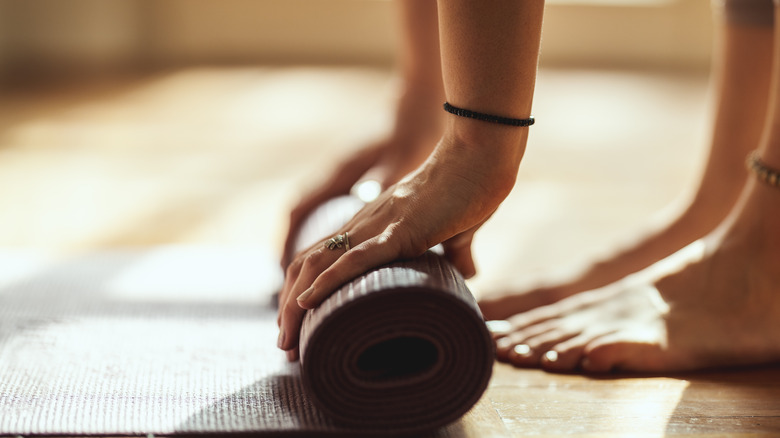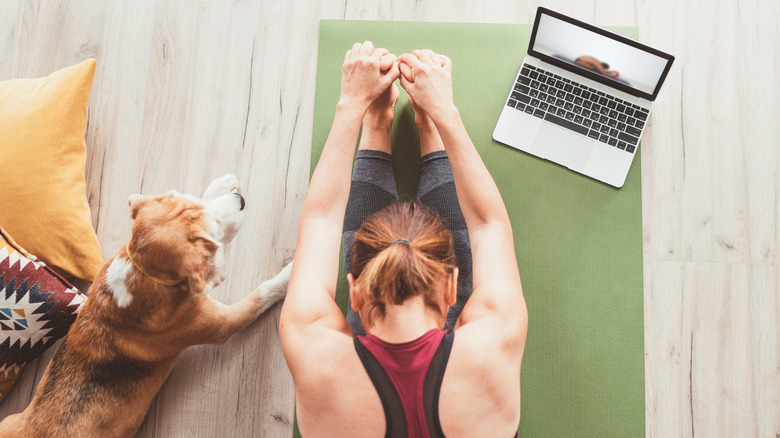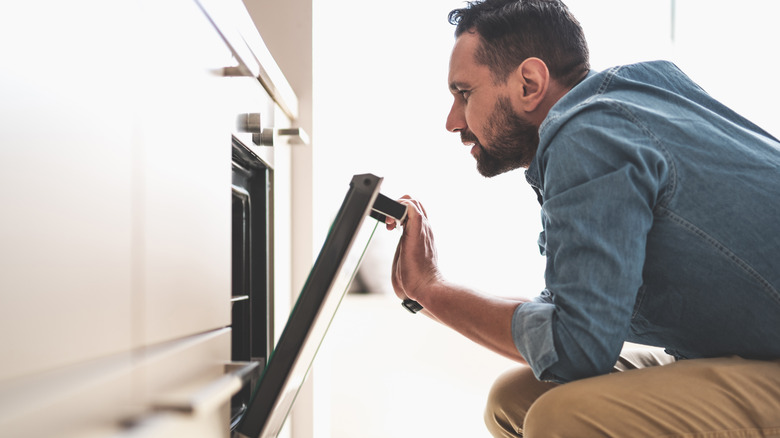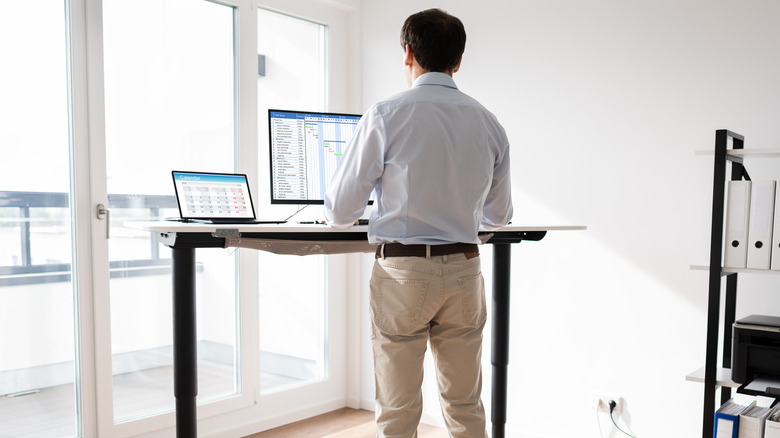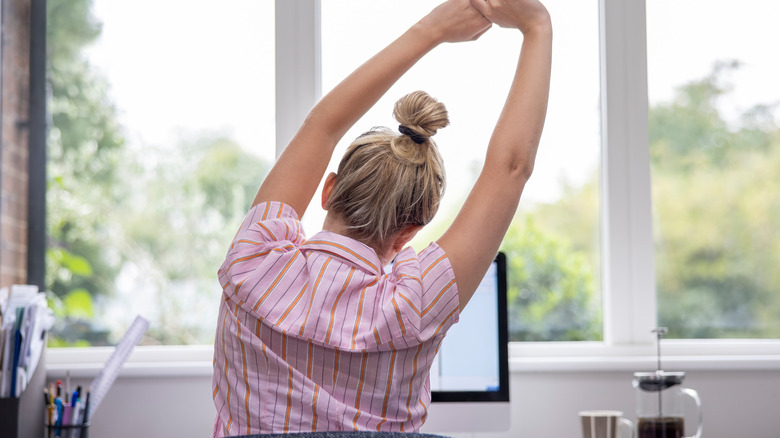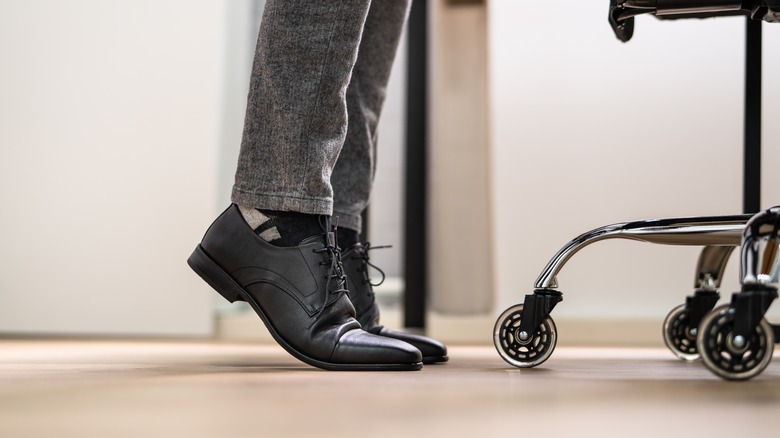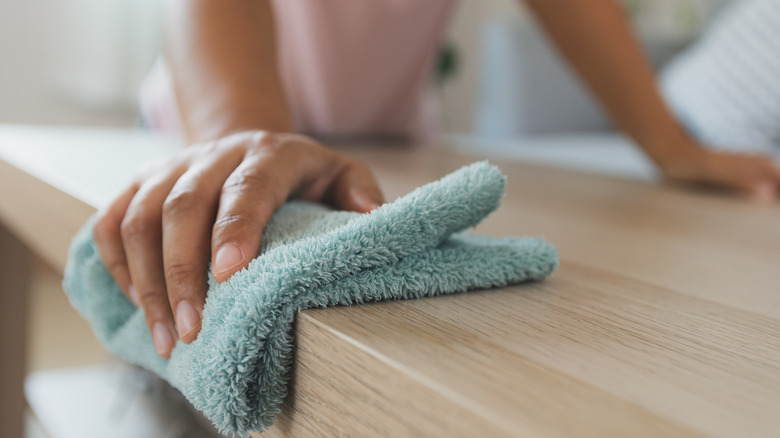14 Ways To Stay Fit When You Don't Have Time To Exercise
There are times when it can feel like a chore just squeezing in time to make yourself breakfast. With packed schedules and the need for some plain old R&R after a long day, squeezing in a workout might be the absolute last thing on your mind. What's worse is that according to experts at Psychology Today, feeling bad about not getting enough exercise can lead to stress, and even depression. So...what to do?
Well, for starters, don't feel bad. Secondly, even if your planner resembles a tightly packed game of tetris, there are ways to squeeze in ways to stay fit into your schedule. Physical activity is essentially a non-negotiable if you want to stay healthy, yet studies have shown that less than 5% of adults are getting the recommended 30 minutes of exercise a day (per Medical News Today). Yikes. Experts at the site say the dangers of living a sedentary lifestyle are many. Sedentary behavior, which is defined as behavior where you don't expend much energy (think sitting or lying down), can lead to obesity, cardiovascular disease, and even some types of cancer.
That said, finding ways to squeeze in a quick fitness routine can be relatively easy. Continue reading to discover 14 ways to stay fit even when your schedule doesn't allow it.
Walk the dog
Man's best friend has now become your new workout buddy. Instead of thinking of walking the dog as another thing to check off your to-do list, why not think of it as a way to burn a few extra calories?
If you have a dog, it's inevitable that you'll have to take him or her out for a walk. It might not seem like much, but according to Mayo Clinic, a brisk walk bears some serious health benefits. For example, a brisk walk can help improve muscle endurance, increase your energy levels, prevent and manage heart disease, and boost your mood. If you're used to just walking down the street and back again, why not extend your walk a few extra blocks next time? And while you're at it, pick up the pace.
Experts at the clinic explain that walking faster can help you get some aerobic activity in, improve your endurance, and burn more calories. Furthermore, the site suggests alternating between walking at a faster pace and a slower pace, which is a type of interval training. Don't worry, your dog will more than likely be able to keep up.
Take the stairs
Elevators are a modern-day convenience that are good for many things — except keeping you in shape. While there are some times that getting in an elevator is an absolute necessity (if you work on the 50th floor for example), there are other times when taking the stairs is absolutely within reach.
According to Verywell Health, climbing the stairs is categorized as a "vigorous intensity physical activity," and actually burns more calories per minute than jogging. When compared to taking the elevator, climbing the stairs expends about seven time as much energy, and when compared to sitting, it expends eight to nine times more. A study published in the journal Stroke that studied over 11,000 men showed that men who climbed 20 flights of stairs per week significantly reduced their long-term risk of stroke.
Furthermore, experts at Verywell Health explain that taking the stairs can actually strengthen your muscles, as it requires the use of various muscle groups — namely your core, clutes, and calves — which can ultimately lead to an improved musculoskeletal system.
Bike to work
Want to save gas, skip the annoying rush hour traffic, and get a good workout in to boot? Leave your car in the garage and bike to work instead.
Jessica Mazzucco, a New York City-based certified fitness trainer, spoke to Verywell Health and said that riding a bike to work "improves mental well-being by combining physical exercise with being outdoors and exploring new views," which is a lot of bang for your buck. Aside from weight loss and improved fitness, some of the fringe benefits you may experience biking to work include improved mental health, saving some cash, and a better perspective on the environment. Biking falls into the category of aerobic activity, which is proven to be good for the heart.
Regarding your muscles, biking specifically targets your glutes, hamstrings, calves, and quads, so every day is leg day when biking to work. For those who are concerned about their joints — not to worry. Biking is a low-impact activity, which means that it is less likely to injure you when compared to other activities such as jumping or running.
Take a walk during your lunch break
Feeling a little burnt out from all the goings-on at the office and need a break from it all? Use your lunch break to step away from the office politics — and get some steps in, while you're at it.
According to experts at Verywell Fit, using your 30 minute lunch break can help you burn at least 200 calories depending on your weight and how fast you walk, still leaving time for lunch before or after. According to the website, the CDC recommends at least 150 minutes of moderate exercise a week, which could include a brisk walk. In addition to the physical benefits this walk could bring, one study published by the Scandinavian Journal of Medicine & Science in Sports showed that walking also improved the "enthusiasm, relaxation, and nervousness at work," of women who were previously inactive.
To start your daily walk practice, map out a route that involves the fewest stop lights so you can spend the bulk of your time walking. Make sure you bring a pair of comfortable walking shoes, and aim to reach a heart rate between 50% to 70% of your maximum heart rate, which you can track by taking your pulse. Furthermore, don't be afraid to invite a friend for more motivation.
Wake up early and squeeze in some aerobics
If you don't have time during the day to work out, making some time in the morning is the next best thing. If you're concerned about having to drive to the gym first thing to get your workout in, don't worry — you can exercise from the comfort of your own home.
According to Healthline, there are several benefits to working out in the A.M., one of which is the fact that you are facing fewer distractions than if you were to workout during the day, which will help you stay focused and motivated. Another benefit is that because working out tends to give you energy, you're setting yourself up to have more of it throughout the day.
There is also evidence that a morning workout may be more beneficial in terms of helping you lose weight. A study published in EBioMedicine that evaluated 10 non-obese men found that there was more fat oxidation when the men exercised before breakfast than at other times. In another Healthline publication, experts suggest a quick 10 minute workout in the A.M., which will start with a warm up of easy cardio such as running in place or jumping jacks. You can follow that up with a mix of speed skating moves, planks, and bridges to work your core and upper body.
Do some yard work
Have some leaves that need raking? Don't discount this seemingly banal activity — put some extra "oomph" in it. Raking the leaves isn't the only outdoor activity that can help you burn some extra calories. Shoveling the snow, pulling weeds, and mowing the grass can also help you get fit.
Joshua Margolis, a personal trainer and the founder of Mind Over Matter Fitness in New York City, spoke to WebMD about the benefits of using yard work as a source of exercise. "Depending on the season, you can always do something that's very energy-consuming: shoveling snow in the winter, raking and bagging leaves in the spring, summer, and fall," explains Margolis. If you're wondering how many calories each of these activities burns, WebMD has you covered. Shoveling snow can average you about 400 to 600 calories per hour, while raking and bagging leaves will leave you with a deficit of about 350 to 450 calories per hour.
Margolis adds, "Raking and bagging leaves is particularly good because you also do a lot of bending, twisting, lifting, and carrying — all things that can build strength and engage a lot of muscle fibers."
Do some yoga while the kids are watching a movie
This one will require some multitasking, but if your schedule is this packed to the brim, you're probably already used to doing more than one thing at a time. Assuming that a kid's movie is going to be approximately an hour and a half in length, this leaves you plenty of time to toss down a yoga mat, do your routine, and spend the remaining hour in savasana if you wish.
The benefits of yoga have been documented at length, and Johns Hopkins Medicine names improving strength, balance, and flexibility at the top of their list. They also mention the potential for back pain relief with certain postures such as "cat-cow pose," which can help improve mobility. Furthermore, if you are experiencing stress, yoga can also help bring you to a state of calm.
According to experts at Verywell Mind, yoga encourages participants to clear their minds, control their breathing, relax the body, and focus, all of which can lead to a reduction in stress. If you're wondering where to start, you can either subscribe to a paid online service that leads classes, or find plenty of free videos on YouTube.
Do some squats while dinner is cooking
Getting fit when you're busy is all about creative thinking. After you've prepped your meal and have popped it in the oven or are waiting for it to come together on the stove, why not use that precious time in-between to pop a few squats?
Squats are a relatively quick and simple exercise to do while standing in place that don't require a lot of space. According to WebMD, squats focus on the lower body and specifically target glutes, quads, hips, hamstrings, calves, and your obliques. They also burn calories, help to improve your bone mineral density, and can improve flexibility.
It's important to do squats correctly, because when done with the improper form, they commonly lead to injury. To do a squat, start with your feet hips width apart. Put your hands on your thighs and look straight ahead with your chest lifted. Next, slowly bend your knees until they are at 90 degrees, placing your weight on your heels. Hold this position for five seconds, then raise yourself up, again placing the weight in your heels until you are upright. You can repeat this five times, or as many times as you like.
Try a standing desk
One of the negative side effects of modern-day offices is their contribution to a sedentary lifestyle. If you think about it, most people drive to work. After they arrive at their office, they're seated for at least eight hours a day, and then drive home to work again, to perhaps stand (or squat) while making dinner, and then go back to bed. That's a lot of downtime.
According to Healthline, sitting too much can have some pretty significant health consequences. Some of those consequences include an increased risk of heart disease, diabetes, and early death. Not good. For those whose work requires them to be seated, a standing desk can offer an excellent opportunity to reduce those risks. While it might not seem like it would make that much of a difference, experts at Healthline explain that standing instead of sitting at work for an afternoon burns an extra 170 calories per day.
What's more, standing has been shown to help reduce blood sugar levels. In a study published by Occupational and Environmental Medicine, researchers found that those who ate lunch and stood instead of sitting afterwards saw a reduction in blood sugar spikes by 43%.
Play with your kids
It's easy to see your kids running around outside or on the playground and think that what they're doing is for them. But when was the last time you had a little fun?
There's a reason most kids are generally pretty happy, and it might just have something to do with all that play. Experts at Colorado State University shared some tips on how to make play a whole family activity to increase fitness and overall wellbeing for all involved. The site explains that for kids between the ages of 6 and 18, 60 minutes of moderate activity is recommended per day. They go on to say that before you stress out about signing your kid up for karate class, this recommendation is loose — meaning the activity can take whatever shape necessary as long as it's moderate in nature.
Furthermore, you can divide the 60 minutes up over the course of a day — it doesn't have to be all at once. One way to make it easy is to set up a routine. Whether it's taking a family walk after dinner, having family sports day at the park each week, or playing soccer in the backyard on Tuesdays, they can all contribute to your family's fitness.
Work out at your desk
By now, you're aware of a couple different ways to stay fit at the office — and the good news is that there's even more. Sneaking a workout in at your desk is actually easier and more streamlined than you may think.
Experts at Healthline compiled a solid list of exercises that can be done from the comfort of your desk, some of which can even be done during conference calls (provided there is no video). If you want to work your arms, why not give some triceps dips a try? To modify them to work at your desk, stand up with a chair without wheels behind you. Place your palms on the chair and place your feet on the ground with your legs at a 90-degree angle. Lower yourself without allowing your bottom to touch the ground, and raise yourself back up. You can repeat this for 10 reps, or as many as you can do.
Another great desk exercise that you can do while sitting are oblique twists. This one works with a swiveling chair. Sit in your chair, then grab the desk in front of you with your hands. While holding firmly to the desk, swivel your chair to the left and the right while keeping your arms in position.
Do calf raises instead of standing still
If you find yourself waiting in the checkout line mentally checking out by scrolling through social media, why not put your phone down and do something good for your body instead?
Yes, it might look a little goofy, but you only live once, and you might as well do it with some excellent looking calves. According to experts at Verywell Fit, our calf muscles are used for some pretty important movements, including walking, reaching, and jumping, and showing them some love in the form of calf lifts can further assist us in doing those things.
To do a calf lift, stand with your feet shoulder width apart. As you do the exercise, make sure that your back is straight, that your core muscles are engaged, and that your shoulders are back and pulled down. When in position, raise your heels slowly without locking your knees. Hold the position on your tiptoes for at least a second, and then lower yourself back to the ground. Repeat as many times as necessary, or until the person in front of you has finished checking out.
Do chores
Here is another great way to turn something mundane into an opportunity to burn a few extra (hundred) calories. Very few people look forward to doing chores, so if getting a workout in for the day feels like motivation for you to jump in, you should probably roll with it.
While indoor chores may not burn as many calories as outdoor ones, you will still burn more than if you were to outsource your chores and sit on the couch. According to WebMD, "major cleaning" tasks, such as rotating mattresses, washing the windows, and washing the cars will net you 175 to 200 calories per hour, "moderate housekeeping" such as laundry, mopping, sweeping, and vacuuming will net you 150 to 300, and "light housekeeping" such as dusting and taking out the trash will net you approximately 120 to 170.
One way to turn these types of tasks into more of a workout is to go old school. For example, instead of using a mop bucket that has a wringer attached, why not bend down and wring the mop out by hand? If you have some clothes to wash, you can also take the opportunity to wash them by hand.
Take a quick dance break
If you've been sitting for too long and are feeling stiff and in a general slump, one of the best ways to shake it off is by getting up to take a quick dance break.
The benefits of dance extend far beyond burning just a few calories. You've probably noticed these changes after a quick session before, and according to Healthline, emotional and mental health are two of the positive side effects of dancing. Regarding the physical, Healthline states that dancing is an excellent cardiovascular workout, as it can elevate your heart rate significantly depending on the type of dance and the duration.
Professional dancer Jonathan Tylicki, the director of education for AKT, a boutique fitness concept rooted in dance, spoke to Healthline and explained, "Movements that we typically do in our daily life, like walking, taking the stairs, and common workouts like treadmills and cycling, occur in the sagittal plane, but dance works your body from all planes, including lateral and rotational, which turns on and conditions all muscles, meaning no muscle is left behind." Furthermore, the site explains that dancing can be gentle on your body, making it ideal for those who have injuries or limited range of motion.

